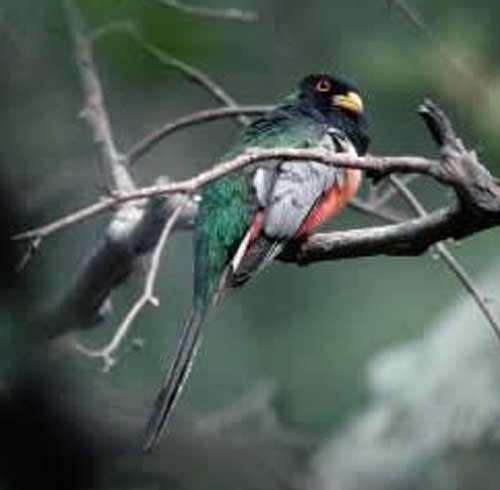
Trogon elegans (US Fish and Wildlife Service)
Superregnum: Eukaryota
Regnum: Animalia
Subregnum: Eumetazoa
Cladus: Bilateria
Cladus: Nephrozoa
Superphylum: Deuterostomia
Phylum: Chordata
Subphylum: Vertebrata
Infraphylum: Gnathostomata
Megaclassis: Osteichthyes
Superclassis: Sarcopterygii
Superclassis: Tetrapoda
Cladus: Reptiliomorpha
Cladus: Amniota
Classis: Reptilia
Cladus: Eureptilia
Cladus: Romeriida
Subclassis: Diapsida
Cladus: Sauria
Infraclassis: Archosauromorpha
Cladus: Crurotarsi
Divisio: Archosauria
Cladus: Avemetatarsalia
Cladus: Ornithodira
Subtaxon: Dinosauromorpha
Cladus: Dinosauriformes
Cladus: Dracohors
Cladus: Dinosauria
Ordo: Saurischia
Cladus: Eusaurischia
Cladus: Theropoda
Cladus: Neotheropoda
Cladus: Averostra
Cladus: Tetanurae
Cladus: Avetheropoda
Cladus: Coelurosauria
Cladus: Tyrannoraptora
Cladus: Maniraptoromorpha
Cladus: Maniraptoriformes
Cladus: Maniraptora
Cladus: Pennaraptora
Cladus: Paraves
Cladus: Eumaniraptora
Cladus: Avialae
Infraclassis: Aves
Cladus: Euavialae
Cladus: Avebrevicauda
Cladus: Pygostylia
Cladus: Ornithothoraces
Cladus: Euornithes
Cladus: Ornithuromorpha
Cladus: Ornithurae
Cladus: Carinatae
Parvclassis: Neornithes
Cohors: Neognathae
Cladus: Neoaves
Ordo: Trogoniformes
Familia: Trogonidae
Genus: Trogon
Species: Trogon elegans
Subspecies: T. e. ambiguus - T. e. canescens - T. e. elegans - T. e. goldmani - T. e. lubricus
Name
Trogon elegans Gould, 1834
References
Proceedings of the Zoological Society of London Pt2 no.16 p. 26
Vernacular names
English: Elegant Trogon
The elegant trogon (Trogon elegans) (formerly the "coppery-tailed" trogon) is a near passerine bird in the trogon family.[2] Along with the eared quetzal, it is the most poleward-occurring species of trogon in the world, ranging from Guatemala in the south as far north as the upper Gila River in Arizona and New Mexico. The most northerly populations of subspecies ambiguus are partially migratory,[3] and the species is occasionally found as a vagrant in southeasternmost and western Texas.
It is a resident of the lower levels of semi-arid open woodlands and forests. It nests 2–6 metres (7–20 ft) high in an unlined shallow cavity, usually selecting an old woodpecker hole, with a typical clutch of 2–3 eggs.
Description
This species is 28–30 centimetres (11–12 in) long and weighs 60–78 grams (2.1–2.8 oz) (average 68 grams (2.4 oz)). Like other trogons, elegant trogons have distinctive male and female plumages (sexual dimorphism), with soft feathers. Both sexes have a white undertail with fine horizontal black barring. The undertail also has large white tips spaced evenly ending in a black terminal band. Both have a yellow bill, orange-red undertail coverts and lower belly, and a white horizontal breast stripe.[4]
Female
The male elegant trogon has a metallic deep green head, upper breast and back, black face and throat, and red-orange lower breast and belly. He shows grey upperwing coverts. The female has a metallic bronze head, upper breast, back, upper tail and upperwing coverts. She shows a dull white upper belly, and a small white vertical stripe behind the eye.
The usual call is a croaking "co-ah co-ah co-ah". The trogon will also include some chattering notes.
The elegant trogon is listed as endangered in the state of New Mexico. It prefers to live in conditions that would favor the presence of pineoak woodlands and local water making it particularly susceptible to disturbance.[5]
Diet
Elegant trogons feed on insects and fruit, often taken in flight. Their broad bills and weak legs reflect their diet and arboreal habits. Although their flight is fast, they are reluctant to fly any distance. They typically perch upright and motionless.
Subspecies
T. elegans has five recognized subspecies, including the nominate subspecies:[2]
T. e. ambiguus Gould, 1835
T. e. canescens Van Rossem, 1934
T. e. elegans Gould, 1834
T. e. goldmani Nelson, 1898
T. e. lubricus J. L. Peters, 1945
References
Male Elegant Trogon from behind
BirdLife International (2016). "Trogon elegans". IUCN Red List of Threatened Species. 2016: e.T22726830A94932954. doi:10.2305/IUCN.UK.2016-3.RLTS.T22726830A94932954.en. Retrieved 12 November 2021.
"Trogon elegans Gould, 1834". Integrated Taxonomic Information System. Retrieved 4 May 2011.
Elegant Trogon at Encyclopedia of Life
Kunzmann, M; Hall, L; Johnson, R (1998). "Elegant Trogon (Trogon elegans)". The Birds of North America Online. Ithaca: Cornell Lab of Ornithology. doi:10.2173/bna.357. Retrieved 6 May 2017.
Hall, Mannan, Linnea, William (1999). "Multiscaled Habitat Selection by Elegant Trogons in Southeastern Arizona". The Journal of Wildlife Management. 63 (2): 451–461. doi:10.2307/3802630. JSTOR 3802630.
A Guide to the Birds of Costa Rica by F. Gary Stiles, Alexander F. Skutch, ISBN 0-8014-9600-4
Trogons And Quetzals Of The World by Paul A. Johnsgard, ISBN 1-56098-388-4
Retrieved from "http://en.wikipedia.org/"
All text is available under the terms of the GNU Free Documentation License

